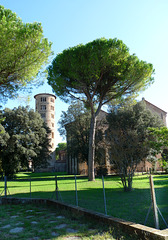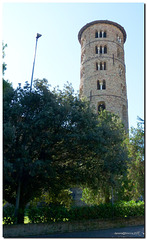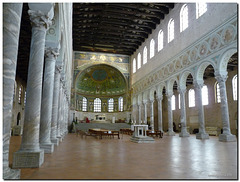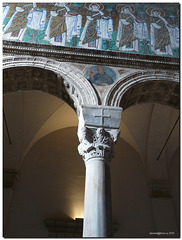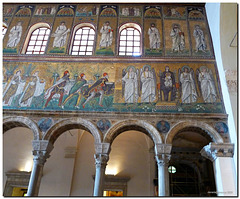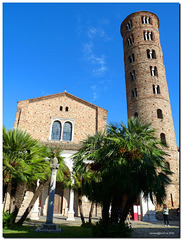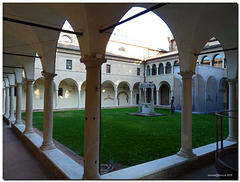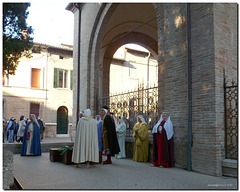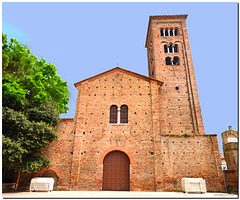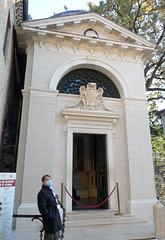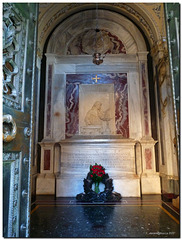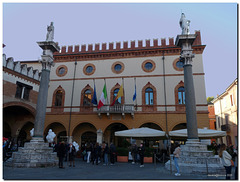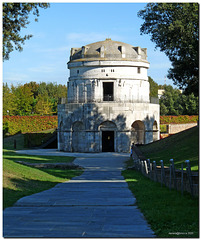
Ravenna,Comacchio e Delta del Po
Bufale di Davide Rivalta di fronte alla basilica
| |
|
|
|
Realizzate in bronzo da Davide Rivalta, le cinque Bufale mediterranee che compongono l'opera sono disposte nel prato antistante la basilica di S. Apollinare in Classe, e raffigurate come nell'atto di avvicinarvisi. Ciascun elemento del gruppo di sculture è rappresentato in una relazione precisa e studiata con il paesaggio circostante. La ricerca di Rivalta è caratterizzata dall'uso di un linguaggio figurativo e dall'indagine sul mondo animale, pretesto per analizzare la relazione tra opera, spazio e spettatore.
----------------------------------------------------------
Made in bronze by Davide Rivalta, the five Mediterranean Buffaloes that make up the work are arranged in the lawn in front of the basilica of S. Apollinare in Classe, and depicted as in the act of approaching it. Each element of the group of sculptures is represented in a precise and studied relationship with the surrounding landscape. Rivalta's research is characterised by the use of a figurative language and the investigation of the animal world, a pretext for analysing the relationship between work, space and spectator.
pini marittimi
| |
|
|
|
La Basilica di Sant’Apollinare in Classe si innalza maestosa e solenne a circa 8 km dal centro di Ravenna. Edificata al tempo del Vescovo Ursicino durante la prima metà del VI sec. e finanziata da Giuliano Argentario, fu consacrata dal vescovo Massimiano nel 549 d. C. Sorge su un’area cimiteriale in uso tra la fine del II e l’inizio III secolo, dove ha trovato sepoltura lo stesso protovescovo Apollinare, patrono di Ravenna.
La basilica è inserita, dal 1996, nella lista dei siti italiani patrimonio dell'umanità dall'UNESCO, all'interno del sito seriale "Monumenti paleocristiani di Ravenna".
La chiesa è stata definita come il più grandioso esempio di basilica paleocristiana. Nonostante le spoliazioni subite nel corso dei secoli, conserva tutt’oggi la bellezza della struttura originaria ed è ammirata per gli splendidi mosaici policromi del suo catino absidale e per gli antichi sarcofagi marmorei degli arcivescovi disposti lungo le navate laterali.
Tutta la decorazione del catino absidale risale circa alla metà del VI secolo e si può dividere in due zone:
Nella parte superiore un grande disco racchiude un cielo stellato nel quale campeggia una croce gemmata, che reca all'incrocio dei bracci il volto di Cristo dentro un medaglione circolare. Sopra la croce si vede una mano che esce dalle nuvole, la mano di Dio. Ai lati del disco, le figure di Elia e Mosè. I tre agnelli, che si trovano spostati un po' verso il basso, proprio all'inizio della zona verde, con il muso rivolto verso la croce gemmata, simboleggiano gli apostoli Pietro, Giacomo e Giovanni: siamo probabilmente di fronte alla rappresentazione della Trasfigurazione sul Monte Tabor.
Nella zona inferiore si allarga una verde valle fiorita, con rocce, cespugli, piante e uccelli. Al centro si erge solenne la figura di Sant'Apollinare, primo vescovo di Ravenna, con le braccia aperte in atteggiamento orante, cioè ritratto nel momento di innalzare le sue preghiere a Dio perché conceda la grazia ai fedeli affidati alla sua cura, qui rappresentati da dodici agnelli bianchi, ovvero i dodici apostoli.
La scelta del tema è strettamente legata alla lotta all'arianesimo, poiché ribadisce la natura divina di Gesù Cristo, negata dalla dottrina ariana.
------------------------------------------------------------------------
The Basilica of Sant'Apollinare in Classe rises majestically and solemnly about 8 km from the centre of Ravenna. Built at the time of Bishop Ursicino during the first half of the VI century and financed by Giuliano Argentario, it was consecrated by Bishop Massimiano in 549 AD. It stands on a cemetery area in use between the end of the II and the beginning of the III century, where Apollinare, the patron saint of Ravenna, was buried.
Since 1996, the basilica has been included in the list of Italian UNESCO World Heritage Sites, within the serial site "Early Christian Monuments of Ravenna".
The church has been defined as the most magnificent example of an early Christian basilica. Despite the spoliations suffered over the centuries, it still preserves the beauty of its original structure and is admired for the splendid polychrome mosaics in its apse basin and the ancient marble sarcophagi of the archbishops arranged along the aisles.
All the decoration of the apsidal basin dates back to around the middle of the sixth century and can be divided into two zones:
In the upper part, a large disc encloses a starry sky in which a gem-like cross stands out, bearing the face of Christ inside a circular medallion at the intersection of the arms. Above the cross you can see a hand coming out of the clouds, the hand of God. On the sides of the disc, the figures of Elijah and Moses. The three lambs, which are moved a little downwards, right at the beginning of the green zone, with their muzzle facing the gemmated cross, symbolise the apostles Peter, James and John: we are probably facing the representation of the Transfiguration on Mount Tabor.
In the lower area there is a green flowering valley with rocks, bushes, plants and birds. In the centre stands the solemn figure of Saint Apollinare, the first bishop of Ravenna, with his arms outstretched in prayer, that is, portrayed as he raises his prayers to God to grant grace to the faithful entrusted to his care, represented here by twelve white lambs, the twelve apostles.
The choice of the theme is closely linked to the fight against Arianism, since it reaffirms the divine nature of Jesus Christ, denied by Arian doctrine.
Translated with www.deepl.com/Translator (free version)
Sant'Apollinare in Classe
| |
|
|
|
La Basilica di Sant’Apollinare in Classe si innalza maestosa e solenne a circa 8 km dal centro di Ravenna. Edificata al tempo del Vescovo Ursicino durante la prima metà del VI sec. e finanziata da Giuliano Argentario, fu consacrata dal vescovo Massimiano nel 549 d. C. Sorge su un’area cimiteriale in uso tra la fine del II e l’inizio III secolo, dove ha trovato sepoltura lo stesso protovescovo Apollinare, patrono di Ravenna.
La basilica è inserita, dal 1996, nella lista dei siti italiani patrimonio dell'umanità dall'UNESCO, all'interno del sito seriale "Monumenti paleocristiani di Ravenna".
La chiesa è stata definita come il più grandioso esempio di basilica paleocristiana. Nonostante le spoliazioni subite nel corso dei secoli, conserva tutt’oggi la bellezza della struttura originaria ed è ammirata per gli splendidi mosaici policromi del suo catino absidale e per gli antichi sarcofagi marmorei degli arcivescovi disposti lungo le navate laterali.
Tutta la decorazione del catino absidale risale circa alla metà del VI secolo e si può dividere in due zone:
Nella parte superiore un grande disco racchiude un cielo stellato nel quale campeggia una croce gemmata, che reca all'incrocio dei bracci il volto di Cristo dentro un medaglione circolare. Sopra la croce si vede una mano che esce dalle nuvole, la mano di Dio. Ai lati del disco, le figure di Elia e Mosè. I tre agnelli, che si trovano spostati un po' verso il basso, proprio all'inizio della zona verde, con il muso rivolto verso la croce gemmata, simboleggiano gli apostoli Pietro, Giacomo e Giovanni: siamo probabilmente di fronte alla rappresentazione della Trasfigurazione sul Monte Tabor.
Nella zona inferiore si allarga una verde valle fiorita, con rocce, cespugli, piante e uccelli. Al centro si erge solenne la figura di Sant'Apollinare, primo vescovo di Ravenna, con le braccia aperte in atteggiamento orante, cioè ritratto nel momento di innalzare le sue preghiere a Dio perché conceda la grazia ai fedeli affidati alla sua cura, qui rappresentati da dodici agnelli bianchi, ovvero i dodici apostoli.
La scelta del tema è strettamente legata alla lotta all'arianesimo, poiché ribadisce la natura divina di Gesù Cristo, negata dalla dottrina ariana.
------------------------------------------------------------------------
The Basilica of Sant'Apollinare in Classe rises majestically and solemnly about 8 km from the centre of Ravenna. Built at the time of Bishop Ursicino during the first half of the VI century and financed by Giuliano Argentario, it was consecrated by Bishop Massimiano in 549 AD. It stands on a cemetery area in use between the end of the II and the beginning of the III century, where Apollinare, the patron saint of Ravenna, was buried.
Since 1996, the basilica has been included in the list of Italian UNESCO World Heritage Sites, within the serial site "Early Christian Monuments of Ravenna".
The church has been defined as the most magnificent example of an early Christian basilica. Despite the spoliations suffered over the centuries, it still preserves the beauty of its original structure and is admired for the splendid polychrome mosaics in its apse basin and the ancient marble sarcophagi of the archbishops arranged along the aisles.
All the decoration of the apsidal basin dates back to around the middle of the sixth century and can be divided into two zones:
In the upper part, a large disc encloses a starry sky in which a gem-like cross stands out, bearing the face of Christ inside a circular medallion at the intersection of the arms. Above the cross you can see a hand coming out of the clouds, the hand of God. On the sides of the disc, the figures of Elijah and Moses. The three lambs, which are moved a little downwards, right at the beginning of the green zone, with their muzzle facing the gemmated cross, symbolise the apostles Peter, James and John: we are probably facing the representation of the Transfiguration on Mount Tabor.
In the lower area there is a green flowering valley with rocks, bushes, plants and birds. In the centre stands the solemn figure of Saint Apollinare, the first bishop of Ravenna, with his arms outstretched in prayer, that is, portrayed as he raises his prayers to God to grant grace to the faithful entrusted to his care, represented here by twelve white lambs, the twelve apostles.
The choice of the theme is closely linked to the fight against Arianism, since it reaffirms the divine nature of Jesus Christ, denied by Arian doctrine.
Translated with www.deepl.com/Translator (free version)
.
Campanile
Byzantine columns
Interior
| |
|
|
|
La Basilica di Sant’Apollinare in Classe si innalza maestosa e solenne a circa 8 km dal centro di Ravenna. Edificata al tempo del Vescovo Ursicino durante la prima metà del VI sec. e finanziata da Giuliano Argentario, fu consacrata dal vescovo Massimiano nel 549 d. C. Sorge su un’area cimiteriale in uso tra la fine del II e l’inizio III secolo, dove ha trovato sepoltura lo stesso protovescovo Apollinare, patrono di Ravenna.
La basilica è inserita, dal 1996, nella lista dei siti italiani patrimonio dell'umanità dall'UNESCO, all'interno del sito seriale "Monumenti paleocristiani di Ravenna".
La chiesa è stata definita come il più grandioso esempio di basilica paleocristiana. Nonostante le spoliazioni subite nel corso dei secoli, conserva tutt’oggi la bellezza della struttura originaria ed è ammirata per gli splendidi mosaici policromi del suo catino absidale e per gli antichi sarcofagi marmorei degli arcivescovi disposti lungo le navate laterali.
Tutta la decorazione del catino absidale risale circa alla metà del VI secolo e si può dividere in due zone:
Nella parte superiore un grande disco racchiude un cielo stellato nel quale campeggia una croce gemmata, che reca all'incrocio dei bracci il volto di Cristo dentro un medaglione circolare. Sopra la croce si vede una mano che esce dalle nuvole, la mano di Dio. Ai lati del disco, le figure di Elia e Mosè. I tre agnelli, che si trovano spostati un po' verso il basso, proprio all'inizio della zona verde, con il muso rivolto verso la croce gemmata, simboleggiano gli apostoli Pietro, Giacomo e Giovanni: siamo probabilmente di fronte alla rappresentazione della Trasfigurazione sul Monte Tabor.
Nella zona inferiore si allarga una verde valle fiorita, con rocce, cespugli, piante e uccelli. Al centro si erge solenne la figura di Sant'Apollinare, primo vescovo di Ravenna, con le braccia aperte in atteggiamento orante, cioè ritratto nel momento di innalzare le sue preghiere a Dio perché conceda la grazia ai fedeli affidati alla sua cura, qui rappresentati da dodici agnelli bianchi, ovvero i dodici apostoli.
La scelta del tema è strettamente legata alla lotta all'arianesimo, poiché ribadisce la natura divina di Gesù Cristo, negata dalla dottrina ariana.
------------------------------------------------------------------------
The Basilica of Sant'Apollinare in Classe rises majestically and solemnly about 8 km from the centre of Ravenna. Built at the time of Bishop Ursicino during the first half of the VI century and financed by Giuliano Argentario, it was consecrated by Bishop Massimiano in 549 AD. It stands on a cemetery area in use between the end of the II and the beginning of the III century, where Apollinare, the patron saint of Ravenna, was buried.
Since 1996, the basilica has been included in the list of Italian UNESCO World Heritage Sites, within the serial site "Early Christian Monuments of Ravenna".
The church has been defined as the most magnificent example of an early Christian basilica. Despite the spoliations suffered over the centuries, it still preserves the beauty of its original structure and is admired for the splendid polychrome mosaics in its apse basin and the ancient marble sarcophagi of the archbishops arranged along the aisles.
All the decoration of the apsidal basin dates back to around the middle of the sixth century and can be divided into two zones:
In the upper part, a large disc encloses a starry sky in which a gem-like cross stands out, bearing the face of Christ inside a circular medallion at the intersection of the arms. Above the cross you can see a hand coming out of the clouds, the hand of God. On the sides of the disc, the figures of Elijah and Moses. The three lambs, which are moved a little downwards, right at the beginning of the green zone, with their muzzle facing the gemmated cross, symbolise the apostles Peter, James and John: we are probably facing the representation of the Transfiguration on Mount Tabor.
In the lower area there is a green flowering valley with rocks, bushes, plants and birds. In the centre stands the solemn figure of Saint Apollinare, the first bishop of Ravenna, with his arms outstretched in prayer, that is, portrayed as he raises his prayers to God to grant grace to the faithful entrusted to his care, represented here by twelve white lambs, the twelve apostles.
The choice of the theme is closely linked to the fight against Arianism, since it reaffirms the divine nature of Jesus Christ, denied by Arian doctrine.
Translated with www.deepl.com/Translator (free version)
.
Column and mosaics
| |
|
|
Come tutte le chiese di Ravenna, dei periodi imperiale (fino al 402-476), ostrogotico (fino al 476-540) e giustinianeo (dal 540-565 in poi), anche Sant'Apollinare Nuovo è decorata con meravigliosi e coloratissimi mosaici. Tuttavia essi non risalgono alla stessa epoca: alcuni sono teodoriciani, altri risalgono alla ridecorazione voluta dal vescovo Agnello, quando l'edificio venne riconsacrato al culto cristiano cattolico.
--------------------------------------------------------------
Like all the churches in Ravenna, from the imperial (up to 402-476), Ostrogothic (up to 476-540) and Justinian (from 540-565 onwards) periods, also Sant'Apollinare Nuovo is decorated with wonderful and colourful mosaics. However, they do not date back to the same period: some are Theodorician, others date back to the redecoration wanted by Bishop Agnello, when the building was re-consecrated to Catholic Christian worship.
Mosaics
| |
|
|
|
Come tutte le chiese di Ravenna, dei periodi imperiale (fino al 402-476), ostrogotico (fino al 476-540) e giustinianeo (dal 540-565 in poi), anche Sant'Apollinare Nuovo è decorata con meravigliosi e coloratissimi mosaici. Tuttavia essi non risalgono alla stessa epoca: alcuni sono teodoriciani, altri risalgono alla ridecorazione voluta dal vescovo Agnello, quando l'edificio venne riconsacrato al culto cristiano cattolico.
--------------------------------------------------------------
Like all the churches in Ravenna, from the imperial (up to 402-476), Ostrogothic (up to 476-540) and Justinian (from 540-565 onwards) periods, also Sant'Apollinare Nuovo is decorated with wonderful and colourful mosaics. However, they do not date back to the same period: some are Theodorician, others date back to the redecoration wanted by Bishop Agnello, when the building was re-consecrated to Catholic Christian worship.
Sant'Apollinare Nuovo
| |
|
|
La basilica fu fatta erigere dal re goto Teodorico nel 505 come chiesa di culto ariano con il nome di Domini Nostri Jesu Christi. Fu la chiesa palatina di Teodorico (cioè una chiesa per l'uso della sua corte).
In seguito alla conquista della città da parte dell'Impero bizantino (540) l'imperatore Giustiniano passò in proprietà della Chiesa cattolica tutti i beni immobili già posseduti dagli ariani. Tutti gli edifici legati ai goti e all'arianesimo furono integrati al culto cattolico. La basilica ex teodoriciana venne riconsacrata a San Martino di Tours, difensore della fede cattolica e avversario di ogni eresia.
Sant'Apollinare Nuovo porta i segni tangibili di quest'operazione: la fascia sopra gli archi che dividono le navate era corredata da un ciclo di mosaici con temi legati alla religione ariana. Su iniziativa del vescovo Agnello, il ciclo fu cancellato e la fascia ridecorata ex novo. Furono risparmiati solo gli ordini più alti (con le "Storie di Cristo" e con i profeti), mentre nella fascia più bassa, quella più grande e più vicina all'osservatore, si procedette a una vera e propria ridecorazione, che salvò solo le ultime scene con le vedute del Porto di Classe e del Palatium di Teodorico, sebbene epurate per una damnatio memoriae[2] di tutti i ritratti, che probabilmente appartenevano a Teodorico stesso e ai suoi dignitari.
Nell'anno 725 la chiesa venne danneggiata da un violento terremoto, che ne fece crollare l'abside. Il sisma demolì anche la Basilica petriana di Ravenna.
La basilica assunse il suo nome attuale solo intorno al IX secolo dopo che vi furono portate le reliquie di sant'Apollinare, primo vescovo di Ravenna, dall'omonima basilica di Classe per sottrarle al pericolo delle scorrerie dei pirati.
Nel corso della prima guerra mondiale, nella notte del 12 febbraio 1916 la chiesa fu bombardata causando gravi danni. L'immagine dell'antica chiesa bizantina sfigurata dalle bombe fece il giro del mondo, suscitando la più ampia riprovazione.
Come tutte le chiese di Ravenna, dei periodi imperiale (fino al 402-476), ostrogotico (fino al 476-540) e giustinianeo (dal 540-565 in poi), anche Sant'Apollinare Nuovo è decorata con meravigliosi e coloratissimi mosaici. Tuttavia essi non risalgono alla stessa epoca: alcuni sono teodoriciani, altri risalgono alla ridecorazione voluta dal vescovo Agnello, quando l'edificio venne riconsacrato al culto cristiano cattolico.
---------------------------------------------------------------------------------------
The basilica was built by the Gothic King Theodoric in 505 as an Aryan church of worship under the name of Domini Nostri Jesu Christi. It was the palatine church of Theodoric (i.e. a church for the use of his court).
After the conquest of the city by the Byzantine Empire (540) the emperor Justinian passed all the real estate already owned by the Aryans to the Catholic Church. All the buildings linked to the Goths and Arianism were integrated into Catholic worship. The former Theodorician basilica was re-consecrated in St. Martin of Tours, defender of the Catholic faith and adversary of all heresies.
Sant'Apollinare Nuovo bears the tangible signs of this operation: the band above the arches dividing the naves was accompanied by a cycle of mosaics with themes linked to the Aryan religion. On the initiative of Bishop Agnello, the cycle was cancelled and the band redecorated ex novo. Only the highest orders were spared (with the "Stories of Christ" and the prophets), while in the lower band, the largest and closest to the observer, a real redecoration was carried out, which saved only the last scenes with views of the Port of Class and the Palatium of Theodoric, although purged for a damnatio memoriae[2] of all the portraits, which probably belonged to Theodoric himself and his dignitaries.
In the year 725 the church was damaged by a violent earthquake, which caused the apse to collapse. The earthquake also demolished the Basilica petriana of Ravenna.
The basilica took its present name only around the 9th century after the relics of St. Apollinare, the first bishop of Ravenna, were brought there from the homonymous basilica of Classe to save them from the danger of pirate raids.
During the First World War, on the night of 12 February 1916 the church was bombed causing serious damage. The image of the ancient Byzantine church disfigured by the bombs went around the world, arousing the widest disapproval.
Like all the churches in Ravenna, from the Imperial (until 402-476), Ostrogothic (until 476-540) and Justinian (from 540-565 onwards) periods, also Sant'Apollinare Nuovo is decorated with wonderful and colourful mosaics. However, they do not date back to the same period: some are Theodorician, others date back to the redecoration wanted by Bishop Agnello, when the building was re-consecrated to Catholic Christian worship.
Translated with www.deepl.com/Translator (free version)
Interno
Cripta allagata in San Francesco
| |
|
|
|
Al disotto del presbiterio si trova la cripta del IX-X secolo, raggiungibile tramite una doppia rampa di scale ed avente come ingresso una piccola finestra ad arco da cui è possibile vedere la cripta senza accedervi. La cripta è a tre navate e coperta con volte a crociera sorrette da quattro colonnine con semplici capitelli geometrici. Sul pavimento, vi sono gli antichi mosaici, risistemati nel 1977; tra questi un'iscrizione che ricorda l'originaria destinazione dell'ambiente, ovvero quella di accogliere le spoglie del vescovo Neone.
Trovandosi sotto il livello del mare l'acqua invade la Cripta come fosse una piccola piscina, dove nuotano anche diversi pesci creando un bellissimo effetto suggestivo.
Dietro la finestra di accesso alla cripta si trova il marmoreo sarcofago di Neone, vescovo di Ravenna nella seconda metà del V secolo e costruttore dalla primitiva chiesa del V secolo.
-------------------------------------------------------
Below the presbytery there is the crypt of the IX-X century, reachable by a double flight of stairs and having as entrance a small arched window from which it is possible to see the crypt without accessing it. The crypt has three naves and is covered with cross vaults supported by four small columns with simple geometric capitals. On the floor, there are the ancient mosaics, rearranged in 1977; among them an inscription that recalls the original purpose of the room, that is to receive the remains of Bishop Neone.
Being below sea level, the water invades the Crypt as if it were a small swimming pool, where several fish also swim, creating a beautiful suggestive effect.
Behind the access window to the crypt is the marble sarcophagus of Neone, bishop of Ravenna in the second half of the 5th century and builder of the primitive 5th century church.
Translated with www.deepl.com/Translator (free version)
Chiostro
Dante is not here
| |
|
|
|
Persone vestite come ai tempi di Dante.Qui accanto c'è la sua tomba.
-----------------------
People dressed as they were in Dante's time. Next to it there is his tomb.
Basilica di San Francesco
| |
|
|
Chi si trova a visitare Ravenna e la Tomba di Dante sicuramente rimane incantato anche dall’adiacente Basilica di San Francesco che, risalente alla metà del V secolo d.C., in origine era dedicata ai Santissimi Apostoli e poi a San Pietro. Della struttura originaria rimane ben poco a causa dei continui rifacimenti, a cui si è aggiunto il robusto campanile quadrato. Venne identificata come Basilica di San Francesco grazie ai frati minori francescani che la scelsero come loro sede. Durante il Medioevo sembra che sia stata la chiesa prediletta dai signori della città, i Polentani, e frequentata da Dante i cui funerali vennero qui celebrati nel 1321.
Sotto l'altare maggiore, costituito da un sarcofago del V secolo, è ben visibile attraverso una finestra, la cripta del X secolo a forma di oratorio sorretto da pilastrini. Il pavimento della cripta è costantemente sommerso dall'acqua poiché si trova sotto il livello del mare e questo fatto è un richiamo costante per i turisti che gettano monetine. Si possono comunque ammirare i frammenti di mosaici della primitiva chiesa, ricollocati nel 1977, e anche un’iscrizione che ricorda l’originaria destinazione di questo ambiente, ovvero quella di accogliere le spoglie del vescovo Neone, fondatore della chiesa.
Per vedere la cripta bisogna sporgere la testa nella piccola finestra, ma questo regala un impatto parecchio suggestivo ed interessante, anche per merito dell’illuminazione interna tramite moneta.
----------------------------------------------------------------------------------
Those who find themselves visiting Ravenna and Dante's Tomb will certainly be enchanted by the adjacent Basilica of St. Francis which, dating back to the middle of the 5th century AD, was originally dedicated to the Holy Apostles and then to St. Peter. Very little remains of the original structure due to the continuous renovations, to which the sturdy square bell tower has been added. It was identified as the Basilica of St. Francis thanks to the Franciscan Friars Minor who chose it as their seat. During the Middle Ages it seems to have been the favourite church of the lords of the city, the Polentani, and frequented by Dante whose funeral was celebrated here in 1321.
Under the high altar, consisting of a 5th century sarcophagus, is clearly visible through a window, the 10th century crypt in the shape of an oratory supported by pillars. The floor of the crypt is constantly submerged by water because it is below sea level and this fact is a constant attraction for tourists throwing coins. However, it is possible to admire the fragments of mosaics of the primitive church, relocated in 1977, and also an inscription that recalls the original destination of this environment, that is to welcome the remains of Bishop Neone, founder of the church.
To see the crypt you have to stick your head out in the small window, but this gives a very suggestive and interesting impact, also thanks to the internal lighting with coins.
Translated with www.deepl.com/Translator (free version)
Tomba di Dante
| |
|
|
|
La tomba di Dante è il sepolcro in stile neoclassico del poeta Dante Alighieri eretto presso la basilica di San Francesco nel centro di Ravenna. Il Sommo Poeta visse gli ultimi anni della propria esistenza nella città romagnola, morendovi nel 1321. La tomba è monumento nazionale ed attorno ad essa è stata istituita una zona di rispetto e di silenzio chiamata "zona dantesca". All'interno dell'area sono compresi la tomba del poeta, il giardino con il Quadrarco e i chiostri francescani, che ospitano il Museo Dantesco.
-----------------------------------------------------------------------
Dante's tomb is the sepulchre in neoclassical style of the poet Dante Alighieri erected near the Basilica of San Francesco in the centre of Ravenna. The Supreme Poet lived the last years of his life in the city of Romagna, dying there in 1321. The tomb is a national monument and around it a zone of respect and silence called "Dante's zone" has been established. The area includes the poet's tomb, the garden with the Quadrarch and the Franciscan cloisters, which house the Dantesque Museum.
Translated with www.deepl.com/Translator (free version)
Interno della tomba di Dante
| |
|
|
La tomba di Dante è il sepolcro in stile neoclassico del poeta Dante Alighieri eretto presso la basilica di San Francesco nel centro di Ravenna. Il Sommo Poeta visse gli ultimi anni della propria esistenza nella città romagnola, morendovi nel 1321. La tomba è monumento nazionale ed attorno ad essa è stata istituita una zona di rispetto e di silenzio chiamata "zona dantesca". All'interno dell'area sono compresi la tomba del poeta, il giardino con il Quadrarco e i chiostri francescani, che ospitano il Museo Dantesco.
-----------------------------------------------------------------------
Dante's tomb is the sepulchre in neoclassical style of the poet Dante Alighieri erected near the Basilica of San Francesco in the centre of Ravenna. The Supreme Poet lived the last years of his life in the city of Romagna, dying there in 1321. The tomb is a national monument and around it a zone of respect and silence called "Dante's zone" has been established. The area includes the poet's tomb, the garden with the Quadrarch and the Franciscan cloisters, which house the Dantesque Museum.
Translated with www.deepl.com/Translator (free version)
Municipio-Town Hall
| |
|
|
|
La Piazza del Popolo fu costruita dai veneziani e rappresenta il fulcro degli interventi di rinnovo urbano attuati sotto il dominio della Serenissima. Le dimensioni della piazza, rimaste a tutt'oggi inalterate, furono definite negli anni 1470-80 in seguito all'ampliamento di un semplice spiazzo lungo la sponda del canale Padenna, che scorreva nel punto in cui ora si erge il palazzo merlato.
Sull'esempio di Piazza San Marco a Venezia, nel 1483 furono erette due colonne a delimitare la piazza verso il corso del Padenna. In cima a quella più vicina al palazzo,dove ora c'è il Municipio, fu collocato il leone di San Marco; sull'altra, la statua del patrono Sant'Apollinare. Dal 1509, anno in cui il pontefice Giulio II prese possesso della città sconfiggendo i veneziani alla Ghiaia d'Adda, le insegne della Serenissima sparirono dalla piazza: il leone sulla colonna fu sostituito dal patrono e al suo fianco comparse la statua di San Vitale.
Dopo la proclamazione del Regno d'Italia, la piazza fu dapprima intitolata a Vittorio Emanuele II. L'attuale denominazione risale al referendum istituzionale del 1946, quando oltre l'88% dei ravennati (la più alta percentuale in Italia) preferì la repubblica alla monarchia.
--------------------------------------------------------
The Piazza del Popolo was built by the Venetians and represents the fulcrum of the urban renewal interventions carried out under the rule of the Serenissima. The dimensions of the square, which have remained unchanged to this day, were defined in the years 1470-80 following the enlargement of a simple esplanade along the bank of the Padenna canal, which flowed at the point where the crenellated palace now stands.
Following the example of St. Mark's Square in Venice, two columns were erected in 1483 to delimit the square towards the course of the Padenna. On top of the one closest to the palace,where now is the Town Hall, the lion of St. Mark was placed; on the other, the statue of the patron saint St. Apollinare. From 1509, the year in which Pope Julius II took possession of the city by defeating the Venetians at the Ghiaia d'Adda, the insignia of the Serenissima disappeared from the square: the lion on the column was replaced by the patron saint and the statue of San Vitale appeared at his side.
After the proclamation of the Kingdom of Italy, the square was first named after Vittorio Emanuele II. The present name dates back to the institutional referendum of 1946, when over 88% of the people of Ravenna (the highest percentage in Italy) preferred the republic to the monarchy.
Translated with www.deepl.com/Translator (free version)
Mausoleo di Teodorico-Esterno
| |
|
|
|
Fatto costruire dallo stesso Teodorico nel 520 d.C. come propria sepoltura, il Mausoleo, interamente realizzato in blocchi di pietra d'Istria, si articola in due ordini sovrapposti, entrambi decagonali.
Al di sopra del mausoleo si innalza una grande cupola monolitica, coronata da dodici anse recanti i nomi di otto Apostoli e di quattro Evangelisti. Le sue misure sono sorprendenti: 10,76 m di diametro e 3,09 m di altezza. Il peso, secondo calcoli recenti, raggiunge le 230 tonnellate.
Da una nicchia si accede all'ordine inferiore la cui destinazione, si presume, fosse quella di una cappella, a pianta cruciforme, usata in origine per servizi liturgici. Al vano superiore si accede attraverso una piccola scala esterna. Qui è collocata una vasca di porfido in cui si presume fosse stato sepolto lo stesso Teodorico, le cui spoglie furono rimosse durante il dominio bizantino, a seguito dell'editto di Giustiniano del 561, quando il mausoleo fu trasformato in oratorio e consacrato al culto ortodosso.
------------------------------------------------------------
Built by Theodoric himself in 520 A.D. as his own burial place, the Mausoleum, entirely made of blocks of Istrian stone, is divided into two superimposed orders, both decagonal.
Above the mausoleum stands a large monolithic dome, crowned by twelve handles bearing the names of eight Apostles and four Evangelists. Its measurements are surprising: 10.76 m in diameter and 3.09 m in height. The weight, according to recent calculations, reaches 230 tons.
A niche gives access to the lower order whose destination, it is presumed, was that of a chapel, with a cruciform plan, originally used for liturgical services. The upper room is accessed through a small external staircase. Here there is a basin of porphyry in which it is presumed that Theodoric himself was buried, whose remains were removed during the Byzantine dominion, following Justinian's edict in 561, when the mausoleum was transformed into an oratory and consecrated to Orthodox worship.
Translated with www.deepl.com/Translator (free version)
Jump to top
RSS feed- Latest items - Subscribe to the latest items added to this album
- ipernity © 2007-2024
- Help & Contact
|
Club news
|
About ipernity
|
History |
ipernity Club & Prices |
Guide of good conduct
Donate | Group guidelines | Privacy policy | Terms of use | Statutes | In memoria -
Facebook
Twitter


